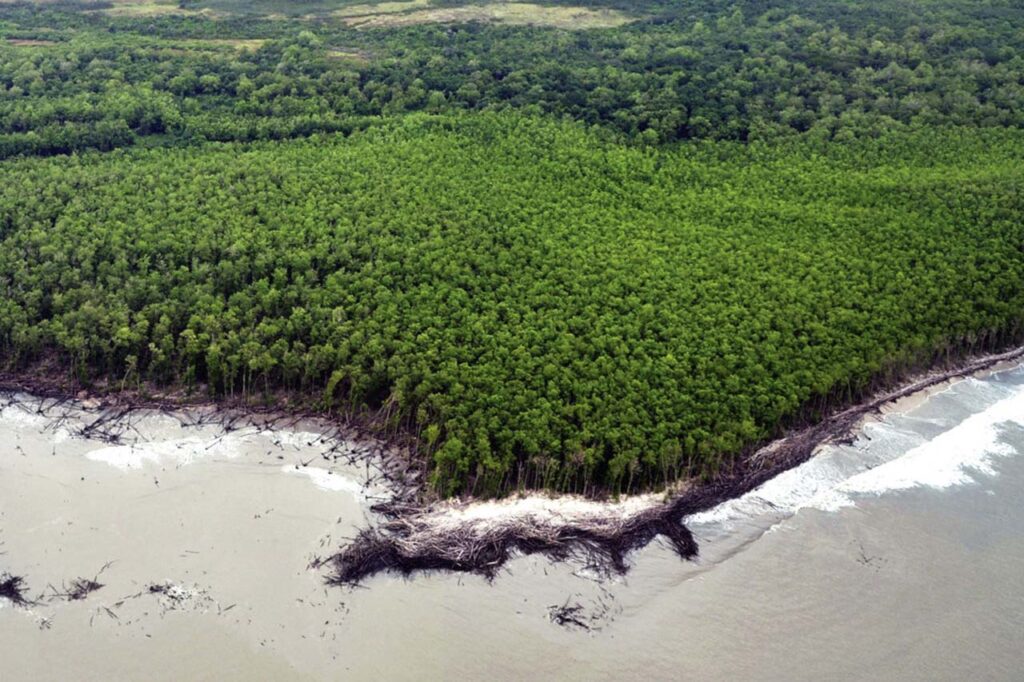[LUM#21] Forests between sea and land
They cover just under 150,000km² of our planet, at the boundary between land and sea, in tropical areas. Mangroves, these extravagant forests, are home to a diverse and threatened biodiversity. Christophe Proisy, a researcher in space remote sensing at the Amap laboratory1, observes this unique ecosystem, whose secrets are still well hidden in the intertwined roots of mangrove trees.

When asked "What are mangroves?", Christophe Proisy answers without hesitation that they are "among the most fascinating forests in the world." These forests are unlike any others, sometimes requiring the researcher to travel dozens of kilometers by boat to reach them, but they can also extend up to 30 kilometers inland. And for good reason: mangroves are " forests that grow in the tidal zone of tropical and intertropical regions," according to the Amap laboratory researcher.
A buffer zone between land and sea, which seems rather inhospitable... Few trees are able to thrive on this muddy, loose soil, which is regularly submerged by brackish water. "The mangrove trees that form mangrove forests have adapted to this constantly changing environment. There are around fifty species worldwide," explains Christophe Proisy , whose work involves documenting the diversity of mangrove tree forms and the dynamics of how the ecosystem functions in relation to coastal dynamics.
Fascinating forests
How do they survive with their feet in salt water? "Some mangroves excrete salt crystals through their leaves," explains the researcher. These remarkable trees have an aerial root system that connects all the trees together, forming the characteristic intertwining patterns of these forests, which are impenetrable in places. "These aerial roots, called pneumatophores, are like snorkels for mangroves: they allow oxygen to be stored at low tide to ensure the plant can breathe during high tide when the soil and roots are submerged, " explains Christophe Proisy. Even the way mangroves reproduce is unique: their seeds can germinate on the tree and then detach from the parent tree to plant themselves directly in the mud or settle further away with the currents, thus extending the mangrove domain.
Mangroves, which can grow up to 45 meters tall in equatorial regions, are supported by a root system that is very shallow but spreads widely across the muddy substrate. "No sediment, no mangroves, " summarizes Christophe Proisy. "If a dam built upstream of the river retains sediment, the mangrove will perish under the inexorable effect of erosion by waves or currents," warns the specialist. Moreover, the artificialization of the coastline, which disrupts hydrodynamics and prevents the natural movement of sediment, is one of the main causes of mangrove disappearance.
Marine nursery
A worrying decline: over the last twenty years, the area covered by mangroves has shrunk by at least 35%. "The conversion of mangrove land into aquaculture ponds is the main factor in the destruction of the ecosystem," says the researcher. And with it, a whole range of biodiversity nestled among the roots of the mangrove trees is disappearing. "Fish fry and juvenile shrimp take refuge there to escape their predators; it's a bit like a marine nursery."
The situation varies around the world. In French Guiana, for example, mangroves cover 80% of the coastline. "Mangroves find optimal conditions there, and in just a few months they can colonize hundreds of hectares of mudflats, growing at a rate of 2 to 4 meters per year," says Christophe Proisy, who has made these 300 km of coastline his research ground. This territory, where jaguars rub shoulders with crabs and shrimp, and where the swell can uproot trees from their mud platforms, remains a mysterious and vulnerable ecosystem. And to better protect it, the researcher has been working for years to understand it better.
Magellan Project
To contribute to this, Proisy will coordinate the Magellan project, funded by the National Program for Nature-Based Solutions, bringing together local stakeholders responsible for managing the Guiana coastline. "One of the main objectives of this project is to reconcile the preservation of this ecosystem with the development of a responsible economy," explains Christophe Proisy. With this in mind, the work will aim to use observations of the spatial dynamics of French Guiana's mangroves to create a warning system for erosion, silting, and the degradation of coastal biodiversity. " Mangroves are also a means of subsistence for many inhabitants who come here to fish or collect mangrove crabs, for example. Magellan also involves humanities and social science surveys to better understand how populations perceive mangroves in the development of the territory.
The project, which began in early 2024, includes an important educational component to raise awareness of this environment and its rich but little-known biodiversity, which is the source of many misconceptions and negative perceptions. "Mangrove mosquitoes have been little studied, and we don't know whether or not they are disease vectors. This question is the subject of a thesis by a student from French Guiana, co-supervised by the Pasteur Institute of French Guiana and the IRD, " explains Christophe Proisy. For the researcher, a better overall understanding of the role of mangroves will also make it possible to better integrate them into sustainable coastal development plans and prevent the disappearance of these fascinating forests, which are essential for the adaptation of human populations on the coasts of the Global South.
Find UM podcasts now available on your favorite platform (Spotify, Deezer, Apple Podcasts, Amazon Music, etc.).
- Amap (UM, CIRAD, CNRS, INRAE, IRD)
↩︎